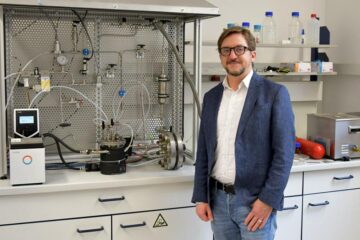Science’s breakthrough of the year: Illumination of the dark, expanding universe

Science honors the top ten research advances of 2003
In 2003, new evidence cemented the bizarre idea that the universe is made mostly of mysterious „dark matter,“ being stretched apart by an unknown force called „dark energy.“ This set of discoveries claims top honors as the Breakthrough of the Year, named by Science and its publisher, AAAS, the nonprofit science society.
These insights into our „dark“ universe plus nine other research advances make up Science’s top ten scientific developments in 2003, chosen for their profound implications for society and the advancement of science. The Top Ten list appears in the journal’s 19 December issue.
This year, information from the Wilkinson Microwave Anisotropy Probe (WMAP) satellite and the Sloan Digital Sky Survey (SDSS) telescopes confirmed some of cosmologists’ strangest proposals about the fate of the universe.
„The implications of these discoveries about the universe are truly stunning. Cosmologists have been trying for years to confirm the hypothesis of a dark universe. Science is glad to recognize their success in this effort as the Breakthrough of the Year for 2003,“ said Don Kennedy, Editor-in-Chief of Science.
Those proposals entered the spotlight five years earlier, when Science’s 1998 Breakthrough of the Year honored the discovery that the universe was expanding. Such an expansion would likely be driven by a „dark energy“ that counters the effects of gravity. At the time, however, many cosmologists were wary of this strange idea.
Their doubts were dispelled in 2003. WMAP took the most detailed picture ever of the cosmic microwave background — the light emitted by the universe during the first instant of its existence. By analyzing patterns in this light, researchers concluded that the universe is only 4 percent ordinary matter. Twenty-three percent is dark matter, which astrophysicists believe is made up of a currently unknown particle. The remainder, 73 percent, is dark energy.
WMAP also nailed down other basic properties of the universe, including its age (13.7 billion years old), expansion rate and density.
The SDSS, an effort to map out a million galaxies, also made major contribution to our understanding of the universe this year. By analyzing how galaxies are spread out through space, the researchers can see if the galaxies are being pulled apart by dark energy or pushed together by gravity.
In October, the SDSS team reported its analysis of the first quarter-million galaxies. Its conclusion was the same as WMAP’s: the universe is dominated by dark energy.
Science also salutes nine other scientific achievements of 2003. Except for the first runner up, the others are in no particular order.
Cracking Mental Illness: Researchers identified particular genes that reliably increase one’s risk of inherited disorders, such as schizophrenia, depression and bipolar disorder. Scientists are now working to understand how these genes can distort the brain’s information processing and prod someone into mental illness. Researchers hope to understand brain biases underlying mental illnesses well enough to design drugs to repair them.
Climate Change Impacts: Global warming was no longer an abstract concept in 2003. Scientists reported melting ice, droughts, decreased plant productivity, and altered plant and animal behavior.
RNA Advances: In 2003, Scientists explored how small RNAs, Science’s breakthrough of 2002, impact a cell’s behavior, from early development to gene expression. Harnessing the power of „small interfering RNAs“ may help researchers combat diseases such as HIV and hepatitis by controlling specific protein production.
Zooming in on Single Molecules: New collaborations between biologists and physicists captured the activities of individual molecules inside cells. Research this year offered a look at molecular motors, colored nanocrystal tags attached to cell receptors and a single enzyme digesting DNA.
Starbursts and Gamma Rays: Scientists improved our understanding of the most energetic explosions in the universe: tremendous blasts of energy called gamma ray bursts. Astronomers confirmed the connection between gamma ray bursts and supernovas–explosions of massive stars–when they spotted the unmistakable fingerprint of a supernova in the glow of a bright gamma ray burst. NASA’s Swift satellite set for launch in mid-2004 should catch gamma ray bursts at five times the rate of any previous mission.
Spontaneous Sperm and Egg Cells: The surprising discovery that mouse embryonic stem cells can develop into both sperm and eggs may help scientists learn how these sex cells develop and why some kinds of infertility arise. The possibility that human embryonic stem cells might someday become a source for human eggs also raised serious ethical questions.
Left-Handed Materials: After two years of debate, several research teams confirmed that certain high-tech materials can bend light and other electromagnetic radiation in the „wrong“ direction. Scientists used this new class of materials to produce an inverse Doppler Effect and are also working to craft better lenses.
The Self-Reliant Y Chromosome: In 2003, the genetic sequence of the human male Y chromosome revealed why this loner chromosome doesn’t need a partner. It has duplicate genes, arranged as mirror-image „palindromes.“ Thus, when mutations arise and a new gene copy is needed, a twin copy is on-hand.
Breakthrough Cancer Therapies?: In June of 2003, researchers announced that an antiangiogenesis drug, given with conventional chemotherapy drugs in a large clinical trial, prolonged the lives of patients with advanced colon cancer. Antiangiogenesis drugs starve tumors by preventing blood vessel growth. With around 60 different antiangiogenesis drugs currently in clinical trials against a wide variety of cancers, researchers and patients now appear poised to reap the benefits of angiogenesis research.
Special SARS Section: Severe acute respiratory syndrome (SARS) clamored onto the world stage in March 2003 after first appearing in November 2002. SARS served as a reminder that new infectious diseases can emerge at any time–and that they don’t have to sicken a lot of people to choke national economies. Thanks to worldwide collaboration, scientists definitively nailed the agent, a member of the coronavirus family, only five weeks after the World Health Organization sounded a global alarm. In the end, low-tech public health measures, such as strict isolation of patients, eventually cornered the virus after more than 8,400 reported cases and more than 916 deaths.
Science’s Breakdown of the Year emerged on 1 February 2003, when the space shuttle Columbia disintegrated as it re-entered the atmosphere after a science mission. The tragedy left seven dead, the shuttle fleet grounded and NASA’s future in question. Much of 2004 could be dedicated to a reexamination of NASA’s civil space program.
Where Researchers Might Soar in 2004: As in previous years, Science highlighted areas to watch in 2004. This year, their choices include three planned Mars landings, microbiology and genomics for biodefense, more insights into the human genome, open access scientific journals, soils’ impact on climate change and sustainable agriculture, the debate over the costs and benefits of tighter security and anti-terror measures in the realm of science, and studies of the heavy „bottom“ quark.
Founded in 1848, AAAS has worked to advance science for human well-being through its projects, programs, and publications, in the areas of science policy, science education and international scientific cooperation. AAAS and its journal, Science, report nearly 140,000 individual and institutional subscribers, plus 272 affiliated organizations in more than 130 countries, serving a total of 10 million individuals. Thus, AAAS is the world’s largest general federation of scientists. Science is an editorially independent, multidisciplinary, peer-reviewed weekly that ranks among the world’s most prestigious scientific journals. AAAS administers EurekAlert! (http://www.eurekalert.org), the online news service, featuring the latest discoveries in science and technology.
Media Contact
Weitere Informationen:
http://www.aaas.org/Alle Nachrichten aus der Kategorie: Förderungen Preise
Neueste Beiträge

Ideen für die Zukunft
TU Berlin präsentiert sich vom 22. bis 26. April 2024 mit neun Projekten auf der Hannover Messe 2024. Die HANNOVER MESSE gilt als die Weltleitmesse der Industrie. Ihr diesjähriger Schwerpunkt…

Peptide auf interstellarem Eis
Dass einfache Peptide auf kosmischen Staubkörnern entstehen können, wurde vom Forschungsteam um Dr. Serge Krasnokutski vom Astrophysikalischen Labor des Max-Planck-Instituts für Astronomie an der Universität Jena bereits gezeigt. Bisher ging…

Wasserstoff-Produktion in der heimischen Garage
Forschungsteam der Frankfurt UAS entwickelt Prototyp für Privathaushalte: Förderzusage vom Land Hessen für 2. Projektphase. Wasserstoff als Energieträger der Zukunft ist nicht frei verfügbar, sondern muss aufwendig hergestellt werden. Das…





















